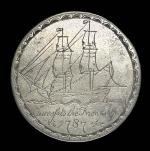Name Friendship Length 23 m Beam 7.01 m | Port of registry Liverpool Construction started 1784 | |
 | ||
Owner George MoorsonThomas HopperGeorge HopperJohn Hopper Fate Scuttled in the Straits of Makassar in 1788. Place built Scarborough, North Yorkshire, United Kingdom | ||
Friendship was a merchant brig built in Scarborough, England, and launched in 1784. She is most notable for her transport of convicts as part of the Australian First Fleet. Due to problems manning her, her crew scuttled her in 1788.
Contents
Origins
The first mention of Friendship in Lloyd's Register gives her master's name as Fowler and her trade as St Petersburg to Lieth. She then disappears from Lloyd's Register before reappearing in the 1787 issue.
Voyage to Australia
Friendship left Portsmouth on 13 May 1787; she was among the smallest of the transports. Her master was Francis Walton and her surgeon was Thomas Arndell. She was carrying 76 male and 21 female convicts, but the record of the number of persons aboard her varies. David Collins gave the following details in his book An Account of the English Colony in New South Wales: "The Friendship, ... of 228 tons, had on board 76 male and 21 female convicts; 1 captain, 2 lieutenants, 2 sergeants, 3 corporals, 1 drummer, and 36 privates, with 1 assistant surgeon to the colony." The New South Wales Marine Corps, a unit especially created for the First Fleet, provided the guards.
Some ten or twelve of the female convicts were particularly unruly, and promiscuous. Walton transferred all the women to other transports at the Cape of Good Hope to make room for livestock purchased there. Friendship arrived at Port Jackson, Sydney, Australia, on 26 January 1788. Two of her female convicts had died on the journey, one before the brig's arrival in Rio, and one after transfer to Lady Penrhyn.
The collection of the National Maritime Museum at Greenwich includes a commemorative coin featuring an image of Friendship and the inscription "Success to the Friendship. 1787." and on the reverse, the inscription "F.W.", the initials of Francis Walton master of Friendship.
Fate
Friendship left Port Jackson on 14 July 1788 in company with Alexander. The two vessels were sailing to Canton to pick up a cargo of tea for the British East India Company.
On the way scurvy badly affected the crews of both ships. By the time the vessels were off the coast of Borneo there only remained enough healthy sailors to work one ship, and her crew scuttled Friendship in the Straits of Makassar (2°S 118°E) on 28 October 1788.
Legal action
The owners took legal action against the Government for the loss of the ship, which took many years.
Commemoration
An Urban Transit Authority First Fleet ferry was named after Friendship in 1986.
